- Home
- S. E. Hinton
Some of Tim's Stories Page 7
Some of Tim's Stories Read online
Page 7
I felt a lot of pressure to write a sequel. I still do feel a lot of pressure to write a sequel. If you go to fanfiction.net, there are more than two thousand Outsider stories, and a lot of them are sequels. I’m fine with fanfiction.net if that helps kids get the feel of writing, but to me The Outsiders stands where it is. I ended it at the right place. I’m not sixteen, no matter how well I remember being that age. I could not capture that moment again, and I don’t want to capture that moment again. But I may write a sequel and put it in my safety-deposit box to be opened after my death, just to keep another writer from doing a sequel after the copyright expires. As much as I don’t mind fanfiction.net, I’m uncomfortable with the thought of somebody else seriously messing with my characters.
Did the title of your second novel, That Was Then, This Is Now, become a personal statement—as well as a great name for your new story?
My subconscious works so well that, yes, it could be a personal statement, now that I look back on it. But at the time I wanted to use it as a metaphor for growing up and suddenly realizing you can’t go on being a little kid. You’ve got to make some tough decisions. Sometimes they’re not going to be the right decisions, but you’ve got to blunder your way through them.
When we first visited, you said that you feel That Was Then, This Is Now is a better book technically than The Outsiders. Can you elaborate on what, in your opinion, makes it better technically?
Because I had a little more control of my emotions; some of The Outsiders is over the top emotionally. You’ve got to control emotion with technique. Talent plus discipline equals art; you can’t have one without the other.
In reviewing That Was Then, This Is Now, the New York Times described it as mature, disciplined. What did you learn writing The Outsiders that made you more proficient when you were writing on That Was Then, This Is Now?
Going through revisions of The Outsiders, I learned not to be overly descriptive, but I’d been writing for many, many years and had been teaching myself the whole time.
You were enrolled at the University of Tulsa when you were working on That Was Then, This Is Now. Did it seem strange to be sitting in a freshman comp class when you’d already made publishing history?
It certainly didn’t make it easier for me to get through freshman comp; that was a hard class.
In what ways are Bryon and Mark, your lead characters in That Was Then, This Is Now, different from Ponyboy and his extended family of friends?
Oh, they’re very different. I try not to repeat my characters at all. When I wrote about Mark, I kept thinking of him as a lion on Bryon’s chain. And Bryon isn’t Ponyboy in that he isn’t as sensitive. He isn’t aware of society until it knocks him in the head. He can’t just sit and observe.
Did you ever find yourself slipping into Ponyboy’s voice when you were writing as Bryon?
I’d left Ponyboy behind by that time, so I never had any trouble with Bryon’s voice.
In That Was Then, This Is Now you do allude to Ponyboy from time to time. He’s become a local hero of sorts; your character Cathy wants to date him in the final chapters in the book. Did referencing him give you a sense of continuity as a writer?
It did in that I wanted to mark the time and place for That Was Then, This Is Now. It happened a few years after The Outsiders, so I have Ponyboy do a walk-through. Also, Bryon, especially in the beginning, didn’t like Ponyboy. He thought he was stuck up, thought he was vain because he was so good-looking. I wanted kids to see how easy it is to make wrong assumptions.
I mentioned how much I admired your edgy description in The Outsiders, your ability to view your characters beyond stereotypes. In That Was Then, This Is Now, you demonstrate that same talent. When Bryon goes to visit Mark in the reformatory, he notes, “He had lost weight but somehow it had stretched his skin over his bones and slanted his eyes. He hadn’t lost his looks but exchanged them.” How distinctly do you see characters in your writer’s eye?
I usually see my characters very, very distinctly. Sometimes I even dream about them. When I do, they’re not the actors; I see the characters. I guess that comes through, because usually people visualize my characters when they’re reading them.
Why do you think some of your readers were frustrated with the way you ended That Was Then, This Is Now?
I’ve always said if you threw the book across the room at the end, you understood it. I wanted to show that there’s not a happy ending for every story. In a lot of ways, growth is betrayal. Things change, no matter how much you’d like them to stay the same.
After the surprise success of The Outsiders, did the publication of That Was Then, This Is Now seem anticlimatic?
Maybe a little bit, but on the other hand it was certainly validation. The first book could have been called a fluke, but with the second, I could safely say I had a career.
Is it true that your third novel, Rumble Fish, actually began as a short story?
Yes, I wrote it for a creative writing class, but I knew it should be a novel. After David and I got married, we went to Europe and were hippies for a while. When we came back and moved to California so he could attend graduate school at Stanford, I started thinking about writing again and pulled out Rumble Fish. Plot is the hardest part of writing for me; I’m good with characters and dialogue. But with Rumble Fish, I already had the plot and finished it in about four months.
Didn’t you originally write it from the viewpoint of Steve, Rusty-James’s friend?
Yes, and I couldn’t stand it. Steve is a very observant, articulate, smart kid. Like Bryon and Ponyboy, he could see a lot; he could say a lot. But I’d done that before. So I rewrote the story from the viewpoint of Rusty-James, who is not observant, not intelligent, and yet he still has to convey the identity of the Motorcycle Boy, who is so complex. I’d write a sentence and be proud of it as a writer, look at it again, think Rusty-James could not say that, and cross it out. As a writer, I’m most proud of Rumble Fish, because it’s very straightforward; there’s no foreshadowing.
You’ve commented in the past that Motorcycle Boy kept haunting you, goading you to tell his story. Did you ever consider telling it from his point of view?
I haven’t got any more clue to what that guy’s mind was like than anybody else does. He’s an enigma to me. I couldn’t tell the story from his point of view. He’s way smarter than I’ve ever been. I was involved in mythology when I wrote this book, and the Motorcycle Boy was doing his community a service by becoming a local myth. At one point he says to Rusty-James, “I’m tired of being the Pied Piper for these people. I can’t lead them. I don’t know anywhere to go.” When he does finally commit suicide by releasing the fish and liberating the pet store, so to speak, he knows he’s creating a bigger myth than if he’d just gotten killed in a rumble.
I’ve heard that you first got the idea for Motorcycle Boy from a magazine photo.
That’s true. I was flipping through a magazine, cut out a picture of this guy with his motorcycle, and then put it away with the idea of writing a story one day. Years later, when I was getting ready to write the book, I looked at the picture again and saw that I had cut it so close to the edge that I couldn’t make out the name of the magazine. After Rumble Fish was published and I was on a publicity tour for my next book, Tex, I was in Washington, D.C., to appear on a television panel with some high school kids. While I was waiting for them in the studio, their teacher walked up to me and pulled out the same magazine photograph. I almost fainted. I had never mentioned the photo to anyone. The teacher explained that he’d thought it was an interesting photograph, had cut it out, then made the connection when he read Rumble Fish. He’d left wider borders, and I could see it came from Saturday Review.
You’ve had so many interesting synchronicities in your life. Did Rumble Fish become representative of your own changing philosophical views? You’d been raised in t
he conservative Christian tradition, then suddenly became exposed to differing views through higher education and travel.
Early on I rejected organized religion. As a child, I went to a very fundamentalist church and saw a man preaching hellfire and brimstone under a sign that said “God is Love.” It turned me against organized religion for the rest of my life. It did not turn me against God. To me, organized religion is like organized social classes, based on exclusion. God is inclusive.
You’ve described Rumble Fish as very stylistic and set in a vague way. Were you concerned at all about how the book would be received? In Rumble Fish, there are no allusions to Ponyboy and your anchor characters; it stands on its own.
Because I was thinking mythically, I wanted the book set in as vague a time and place as possible. When Rusty-James is recalling the good old days with gangs, he might as well have been thinking about when there were knights at the round table. Francis Coppola, who directed the movie version, understood this and told his actors that the story was set two years in the future.
How did the last two pages of Rumble Fish reinforce the overall point you wanted to make with the novel?
All through the book Rusty-James is saying, “I’m just going to be like the Motorcycle Boy.” By the end of the book, he’s staring at a body of water; he goes deaf for a minute; he’s not seeing; he’s not feeling. He has become the Motorcycle Boy, but it’s not what he thought it would be. My point: do not identify with something you don’t define, because you may be getting it all wrong.
After Rumble Fish was published, one critic declared you a brilliant novelist. What was your husband’s reaction? He’d been your primary reader for the book.
David’s the only one I let read works in progress—usually. He’s a mathematician and doesn’t really like to read. I’m a writer and don’t like to add. But I can always count on David to say, “That’s nice, honey,” when I show him my stories. After the critics liked Rumble Fish, he said, “Aren’t you kind of surprised that Rumble Fish is getting such good reviews?” And I’m like, well, no.
All of your young adult novels seem to stand out for you in different ways. What makes Tex your personal overall favorite?
I just loved being that character. I began writing Tex when I was still working on the galleys for Rumble Fish. By the time I was finished with Rusty-James, I felt like I’d been pounding my head against a wall—a stone wall—and I wanted to be somebody happy for a change. And Tex and his brother and his friends were all characters I had actually used in grade school or middle school for a completely different story and setting. It took me over three and a half years to write. I’d get busy and then realize I’d gone sixty pages off on a tangent. I’d put the book in the drawer for a long time, then pull it out and start writing again. It’s the only one of my young adult novels I have ever thought I might like to write a sequel to, maybe using one of the Collins kids as a narrator.
You’ve described Tex as the least tough of your characters. Why is he still so admirable?
He’s the least tough, but he’s the strongest. He’s not going to let things break him. I think of Tex as the counterpoint to That Was Then, This Is Now. Tex learned a bad truth about his family, and it could have turned him against his brother forever, but he didn’t let it.
Mark, your troubled character from That Was Then, This Is Now, reappears in Tex. What unfinished business did you as a writer need to take care of with him?
I really believe that, even though I didn’t realize it at the time, I was writing a different version of That Was Then, This Is Now, showing another road not taken. Something made me put Mark in as the hitchhiker in the story; it’s done very subtly. Even though Tex and Mark are half-brothers, they live in separate worlds.
All your novels seem to revise our conventional definitions of family. How does Tex’s encounter with Mark help you build on that theme?
Mark and Tex are very much alike—so much so that Tex even says the hitchhiker reminds him of somebody, but he can’t think who. They came from different backgrounds but had the same genetic material. There was just something about Tex, though, that was stronger—maybe not so self-indulgent. Mark showed no regret for the way his own immediate family had been lost, whereas it devastated Tex to learn that the man he thought was his father really wasn’t. But he learned to forgive and accept much more than his brother, who actually was Pop’s biological son.
Critics have pointed out that Jamie in Tex is one of your most fully developed female characters. Did you consciously work on building her persona, or did she evolve naturally?
Naturally. I think girls who have a lot of older brothers are, most of the time, pretty spunky. They’ve got to hold their own, and Jamie was making the point that she had a lot more common sense than the guys, so it wasn’t fair that she couldn’t have a motorcycle, too. I felt the same way.
You set Tex in a fictional suburb outside of Tulsa rather than in the city itself. Did that provide you with some flexibility?
I spent a lot time in the country when I was a kid—my grandmother had a farm out in Nowata, and I loved being on that farm. When I was writing Tex, I was living in Bixby, and to a certain degree, it’s a suburb. In small towns there’s a difference. Not that the kids don’t get into their little groups, but economically everybody’s about the same. So the Collins family is an anomaly in Tex.
How closely does Tex’s devotion to his horse parallel your feelings for your own animals?
Negrito in Tex is based on my horse Toyota. I raised him from a colt and broke him to the saddle. I was always one of those horse-crazy little girls, but I had to wait until I was an adult to buy a horse of my own. I was twenty at the time and spent the last seventy-five bucks I had in the bank to buy this four-month-old colt. He still needed milk supplements. When we moved to California, I took him with me and put him with a regular trainer. He turned out to be a champion jumper. I just let him decide what he wanted to do. He died at twenty-three, and I was right there holding his head.
Are horses still as much a part of your life as they were back then?
Not quite as much, because I don’t have the time or the energy. After twenty-five years of showing and riding around the ring, I bought myself a little trail horse.
Not only have you loved horses, you became an accomplished jumper. What makes the sport worth the risk to you?
I like an adrenaline rush. I like challenges. Even as a kid I was braver than I should have been. When I was going to New York to do the publicity for The Outsiders, I’d never been on a jet, but I wasn’t scared. Any time you try to start a new book, it’s damn scary. But there’s something about me that likes to push that button in me that’s scared.
You’ve described your fifth young adult novel, Taming the Star Runner, as a horse story and a love story. Would you agree with novelist Jane Smiley, herself a horse lover, that all horse stories are love stories?
There’s something special about girls and horses, because horses are so big and so powerful, yet they’ll befriend you. They want to know what you want them to do.
You discovered you were pregnant right after you started Taming the Star Runner. What did that do to your writing schedule?
I wrote my editors, told them I wouldn’t be able to do the book for a while, and asked if they wanted their money back. But they told me just to write the book whenever I felt like it, so I mentally retired with my box of chocolate-covered peanuts and a book of baby names, never giving the novel another thought until Nick was about four. I enrolled him in a preschool, where he went three days a week from nine to two, and I rented an office on the same block. I still had my outline for the book, and the characters were in my head. I identified a lot with Travis, because he was a writer, and we’d had some of the same experiences. He sold his first book when he was sixteen, and there’s nobody at home to tell but the cat. People think it
’s autobiographical, but it’s not really. Travis seems especially self-centered.
He’s trying to figure out who he is. That’s the way you are at that age. He’s a good-looking kid; he knows it and is constantly checking in the mirror, but by the last page of the book he’s looking out the window at other people. So he’s maturing. Basically I think Taming the Star Runner is about an artist trying to learn discipline. Travis watches Casey, who’s very talented. She understands the importance of discipline as she works to transform a horse into a wonderful piece of art. By the end of the book, Travis realizes what they’ve got in common—he’s sitting at his typewriter waiting for his next book, and she’s waiting for the artistic challenge of her next horse.
Did you realize as you wrote Taming the Star Runner that it would be your last young adult novel for a while?
I didn’t. I was so identified with the genre, I didn’t even think about that at the time.
Unlike your other early novels, Taming the Star Runner is in third person. Do you think you might have been subconsciously distancing yourself a little bit?
When I’m writing a first-person narration, I really have to become my narrator, and I have to be totally involved with, that narrator. My son was only four years old at the time, and I was emotionally involved with him. I didn’t have anything to spare to become Travis at that point. But I did think I could write a book about Travis. As a writer, I wanted to prove to myself that I hadn’t lost it. It had been eight or nine years since I’d written Tex. But in that time, I had worked on the movies, and I’d had my child and worked on him.
And the book’s dedicated to Nick.
Actually it was supposed to be dedicated to Nick and David. David’s been in all my dedications since That Was Then, This Is Now, but the editor left out the comma between “Nicholas” and “David.” “Nicholas David” is Nick’s full name, so for lack of a comma, a dedication was lost.
As you think through all your young adult novels, do you see a character-writer progression? For example, did you need to write as Ponyboy in The Outsiders before you could ultimately write about Travis in Taming the Star Runner?

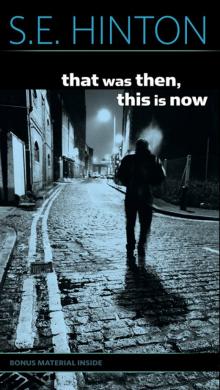 That Was Then, This Is Now
That Was Then, This Is Now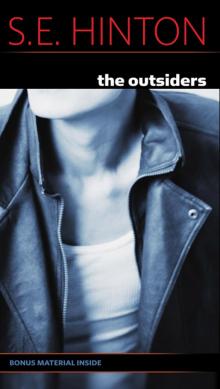 The Outsiders
The Outsiders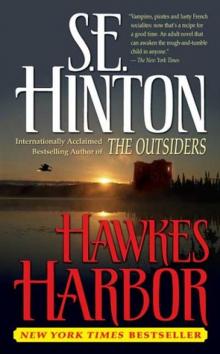 Hawkes Harbor
Hawkes Harbor Taming the Star Runner
Taming the Star Runner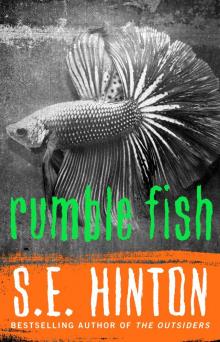 Rumble Fish
Rumble Fish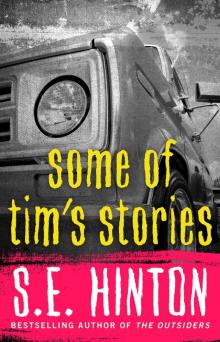 Some of Tim's Stories
Some of Tim's Stories